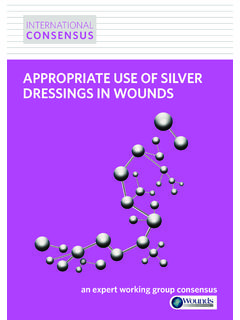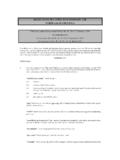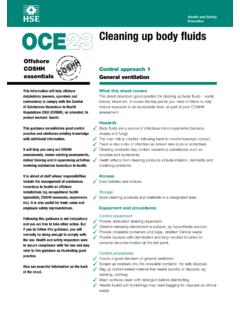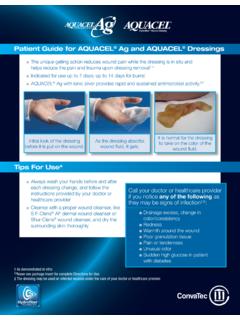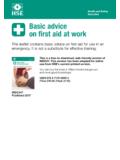Transcription of ASSURING SAFETY OF EGG YOLK-BASED SAUCES …
1 ASSURING SAFETY OF EGG YOLK-BASED SAUCES AND SALAD dressings by O. Peter Snyder, Jr., Hospitality Institute of Technology and Management 670 Transfer Road, Suite 21A St. Paul, Minnesota 55114 USA Abstract For many years, products prepared from raw shell eggs have been implicated in foodborne disease outbreaks. It is now known that there may be the possible presence of Salmonella enteritidis within the yolk of a small percentage of intact, USDA-graded shell eggs. Food microbiologists and public health authorities have named homemade mayonnaise, Caesar dressing, and Hollandaise and B arnaise SAUCES as items that pose risks of a hazard if prepared from raw shell eggs.
2 The SAFETY of these products can be assured if the cook takes specific steps, as presented in this paper, to reduce any possible Salmonella spp. in raw eggs (egg yolks) to a safe level. This can be accomplished when cooks use a preparation method for egg yolks that includes the addition of acid and a pasteurization step that provides a 100,000-to-1 CFU/g (5D) Salmonella reduction before the acidified/pasteurized egg yolks are used in the preparation of these products. Recipe formulations, calculations, directions for preparation, and pH of final products are given.
3 Introduction Raw eggs are a functional ingredient in many SAUCES and salad dressings . In the past, the FDA considered the contents of whole, uncooked shell eggs to be pathogen-free and did not consider the contents of fresh eggs to be a high-risk food. However, possible contamination of intact shell eggs by S. enteritidis was recognized in Europe and the United States during the latter 1980s when it became known that this pathogen could be transferred from the infected ovaries of laying hens to the egg yolk before the shell was formed.
4 USDA grading of shell eggs does not detect the presence of this pathogen. Today, a small percentage of raw shell eggs are contaminated, perhaps 1 in 10,000. This is true throughout the U. S. Unfortunately, one cannot look at the intact shell egg and have any idea about its SAFETY . Therefore, food microbiologists and public health authorities have named homemade mayonnaise, Caesar dressing and Hollandaise and B arnaise SAUCES as items that pose risks of a hazard if prepared from raw shell eggs. However, the SAFETY of these products can be assured if the cook takes specific steps as presented in this paper to reduce any possible Salmonella spp.
5 In raw eggs to a safe level. This can be accomplished when cooks use a preparation method for egg yolks that includes pasteurization which provides the same 100,000-to-1 CFU/g (5D) Salmonella reduction, or greater than is specified for cooking hamburgers. To prevent foodborne illness, public health authorities recommend: (1) using pasteurized intact shell eggs (available in only a few areas of the ), (2) using commercial liquid egg products pasteurized according to USDA specifications (USDA 1969) that are normally only available web:Documents.
6 Mayonnaise print 6/19/09 1 frozen, in large containers, (3) purchasing supplier-certified, salmonellae-free eggs (which are available from only a few suppliers), and (4) cooking eggs until all parts of the egg reach a temperature of at least 145F (63C) for 15 seconds according to the FDA 1995, 1997 Food Codes. (This really is not an adequate pasteurization.) None of these options are practical for a normal retail food operation preparing fresh SAUCES and dressings in small quantity. The microbiological hazard can be eliminated if certain precautions are taken, such as those used in the commercial preparation of mayonnaise.
7 Acid ingredients in mayonnaise, if in sufficient concentration or amount, can eliminate salmonellae from raw egg yolks if given an adequate amount of holding time at room temperature after manufacture. Federal regulations assume the presence of salmonellae in raw eggs used for salad dressings and require that commercially manufactured dressings such as mayonnaise and salad dressing made with unpasteurized eggs must have a pH of less than or equal to , an acetic acid level of the aqueous phase of greater than or equal to , and a holding period of 72 hours before the product is shipped (CFR Title 21 Part and ).
8 These conditions were established to assure destruction of Salmonella and were based on studies of Wethington and Fabian (1950). The use of unpasteurized eggs in mayonnaise or salad dressing by commercial manufacturers was discontinued in the early 1970s and they began using USDA-certified, pasteurized eggs. However, there still may be low contamination of these pasteurized products with low levels of Salmonella spp. Therefore, the acetic/citric acid level in these products remains critical. Commercial mayonnaise in the United States produced in accordance with the FDA Standard of Identity actually contains enough acid to destroy Salmonella spp.
9 And inhibit the growth of other foodborne pathogenic bacteria such as Listeria monocytogenes (Smittle, 1977; Glass and Doyle, 1991; Erickson and Jenkins, 1991; Radford and Board, 1993). This paper will describe a simple egg yolk pasteurization method that incorporates this acid- SAFETY concept. Restaurant chefs and cooks in homes can use this method to assure the SAFETY of SAUCES and dressings made from fresh egg yolks. This method can be used to prepare a few pasteurized egg yolks in advance for use in SAUCES and dressings throughout the day as well as for the immediate preparation of these items.
10 Method for Controlling Salmonellae Contamination in Egg- based SAUCES and dressings The simplest method for controlling microbial contamination and minimizing the risk of foodborne illness in a kitchen is the application of heat. This occurs when products are pasteurized. However, heating fresh eggs (whole or yolks) to temperatures sufficient to decrease microbial hazards for emulsified salad dressings and SAUCES has not been thought by cooks to be possible. This is because most cooks know that when eggs (whites and yolks) are heated above 150F ( ), the egg proteins solidify and become hard.



